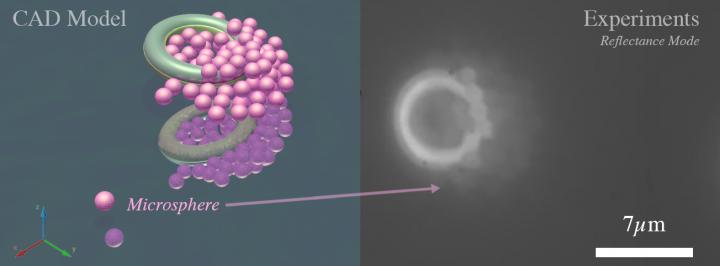Bacteria and other swimming microorganisms evolved to thrive in challenging environments, and researchers struggle to mimic their unique abilities for biomedical technologies, but fabrication challenges created a manufacturing bottleneck. Microscopic, 3D-printed, tori – donuts - coated with nickel and platinum may bridge the gap between biological and synthetic swimmers, according to an international team of researchers.
These micro swimmers mimic biological behavior and might one day deliver targeted drugs or stir samples in labs-on-a-chip – a miniature device that mimics a full laboratory on a microchip.
“These donuts may eventually have medical applications as active materials,” said Igor Aronson, Huck Chair Professor of Biomedical Engineering, Chemistry and Mathematics, Penn State.
Active materials are those that move on their own like bacteria or artificial micro swimmers.

“It’s really hard to get things to mix when using a lab-on-a-chip,” said Remmi Danae Baker, doctoral candidate in material science and engineering, Penn State. “These microtori, because they are active materials and move on their own, could be used to aid in micromixing.”
The researchers manufacture these donuts using a Nanoscribe Photonic Professional GT machine that allows creation of the 3, 7 or 14 micrometer donuts with printed features of up to 200 nanometers. Spider silk is 3 to 10 micrometers in diameter. The Nanoscribe uses precise laser technology and specially designed photoresists to achieve this.
“We create two different designs, horizontal and vertical,” said Baker. “Horizontal tori are printed flat on the supporting glass slide, glazed with nickel and then platinum. Vertical tori are 3D printed upright and are then dipped in nickel and platinum.”
[ad_336]
The horizontal donuts are perfectly circular and look like iced donuts, with the icing thicker on top than on the sides. The vertical version has one flat end so that they stand for dipping and are only dipped halfway.
The nickel serves two purposes. Platinum will not stick to the plastic micro-donuts, but nickel will and platinum will stick to nickel. Also, nickel is magnetic, so the researchers can manipulate the donuts with magnetic fields.
“The lattices of the nickel and platinum layers match up pretty well,” said Baker.
The researchers want the donuts to behave like living organisms – to swim in water and respond to signals. Living things need food or fuel for motion. For the experiment, the researchers placed the microtori in a hydrogen peroxide solution, which was the fuel. Platinum decomposes hydrogen peroxide and powers propulsion of the donuts.
“Originally, it was thought that a horizontal torus would just rise off the substrate and hover, but that doesn’t happen,” said Aronson. “Rather than rise straight up, they begin to tip, reach a 15 degree angle and then they swim like a jet skier.”
While the horizontal microtori move in a straight line, Aronson notes that a vertical torus will not move in the direction of the magnetic field, but as the magnetic field increases, the torus creates larger and large flat loops until the movement becomes a straight line.
The researchers report today (Oct. 30) in Nature Communications that “The tori also manipulated and transported other artificial swimmers, bimetallic nanorods, as well as passive colloidal particles.” The bimetallic rods are similar to bacteria and this is the first step to manipulating biological matter like cells and bacteria.
[rand_post]
The two modes of micro donuts behave differently when transporting particles or active material. Horizontal tori, the ones iced like donuts, actively transport bimetallic nanorods.
The researchers found a number of new behaviors for these 3D printed chemically powered micro swimmers. Both their experimental and modeling approaches are applicable to other micro swimmers powered by alternative methods to hydrogen peroxide. For biological systems, micro swimmers might use bio-compatible propulsion systems like enzymes or light.
The researchers note that “these biocompatible, 3D printed micro swimmers would then be able to interface and manipulate biological active matter leading to the development of intelligent cell transport and therapy.”